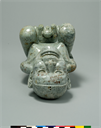Description
This piece is a sculptural rendering of a birthing woman, often identified as the Aztec deity Tlazolteotl. Tlazolteotl is a gender-neutral name, meaning “filth deity”, and thought to be the filth eater, the purifier, the confessor. Informants describe her as one who both gave and took away sin. They mentioned her overlapping identity with Ixcuina, a four-sister weaving goddess. As Tlazolteotl-Ixcuina she was “filth god-Lady Cotton” associated with spinning and weaving and fertility. Yet her role with regard to motherhood was as a fertility goddess at a grandiose scale, not as the patroness of childbirth.
This compelling small sculpture is one of the most famous pieces in the Bliss Collection. Its image has been featured in major exhibitions, graced book pages, and been reinterpreted in popular artistic media. It has been esteemed as an icon of fertility, and even played a featured role in one of the most popular films of all time when it was the object of Indiana Jones’s attentions in the opening scenes of Raiders of the Lost Ark.
In spite of its charisma, some have questioned the piece’s authenticity, and recent studies suggest it may be a nineteenth-century idealized conception of Aztec artistic expression. Despite the controversy the piece has acquired a cultural identity transcending issues of validity. It has become an icon, a rare rendering of the power and pain of childbirth.
Exhibition History
"Twenty Centuries of Mexican Art,", Museum of Modern Art, New York, May 1940.
"Ancient American Gold and Jade", Taft Museum, Cincinnati, OH, 10/6 - 11/19/1950 (catalogue # 32).
"Art méxicain du précolombien à nos jours", Musée National d 'art Moderne, Paris, France, 5/9 - 7/30/1952 (catalogue # 624).
"Mexikansk Konst fran Forntid till Nutid", Liljevalchs Konsthall, Stockholm, Sweden, 1952 (catalogue # 665).
"Exhibition of Mexican Art from Pre-Columbian Times to the Present Day", The Tate Gallery, London, England, 3/4 - 3/26/1953 (catalogue # 631).
"Kunst der Mexikaner", Kunsthaus, Zurich, Switzerland, 1/24/1959 - 3/15/1959 (catalogue # 687); Rautenstrauch Joest Museum/Wallraf-Richartz Museum, Cologne, Germany, 4/25 - 6/7/1959 (catalogue # 132).
"Mexicaanse Kunst", Haags Gemeete Museum, The Hage, Netherlands, 6/26 - 8/23/1959 (catalogue # 29).
"Kunst aus Mexico and Mittelamerika", Akademie der Kunste, Berlin, Germany, 10/5 - 11/22/1959 (catalogue # 1034).
"Prakolumbische Kunst aus Mexico un Mittelamerika", Kunstlerhaus, Vienna, Austria, 12/22/1959 - 2/29/1960 (catalogue # 947).
"The Imagination of Primitive Man", Nelson-Atkins Museum of Fine Arts, Kansas City, MO, 1962.
"Indigenous Art of the Americas", National Gallery of Art, Washington DC, May 1948 to July 1962.
(photo only) "The Arts of Latin America", UNESCO traveling photographic exhibition, Paris, France, 1977.cat. no. 39.
"Azteca Mexica, Las Culturas del Mexico Antiguo", Museo de America, Madrid, 1992.
"Aztecs", Royal Academy of Arts, London, England, 9/12/2002 - 4/11/2003; Ethnologisches Museum, Berlin, Germany, 5/11 - 8/3/2003; Art and Exhibition Hall of the Federal Republic of Germany, Bonn, Germany, 9/26/2003 - 1/11/2004.
"Object and Image: Man Ray, African Art, and the Modernist Lens", The Phillips Collection, Washington, DC, 10/10/09 to 1/10/10
"Inspiring Art: The Dumbarton Oaks Birthing Figure"; Dumbarton Oaks, Washington DC, 06/27/2013 - 03/23/2014
"75 Years/75 Objects", Dumbarton Oaks, Washington DC, 09/08/2015 - 05/22/2016.
Acquisition History
Formerly in the collection of Augustin Alexis Damour (mineralogist), Paris.
Purchased by Dr. Alban Ribemont-Dessaignes (obstetrician), Paris, 1902.
Purchased from Charles Ratton (dealer), Paris, by Joseph Brummer (dealer), New York, June 23, 1933.
Purchased from Joseph Brummer's estate (sold by Ernest Brummer, dealer), by Robert Woods Bliss, New York, June 17, 1947.
Robert Woods Bliss Collection of Pre-Columbian Art, Washington, DC, 1947-1962.
Dumbarton Oaks Research Library and Collection, Pre-Columbian Collection, Washington, DC.









